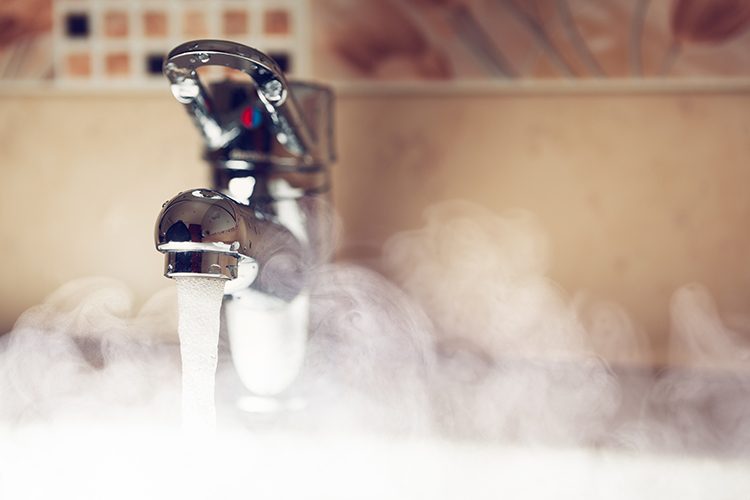DHW, Mixing Valves and Recirculation
How recirculation can make or break your domestic hot water system.

In the June 2024 issue of PHC News (“Hydronics, DHW and Mixing Valves”), we discussed the fact that many hydronic contractors dip their toes into domestic hot water production systems. In many cases, these systems include mixing valves. We spoke about why they’re needed, their sizing and minimum flow requirements.
We also touched on recirculation. Let’s take a deeper look at recirculation and how to get it right when a mixing valve is involved.
One of the biggest issues I take calls about is a phenomenon referred to as recirc creep. You may not know it by name but you’ve likely encountered its symptoms. It usually goes something like this: the customer states that the first use of DHW in the morning is incredibly hot and then everything is fine the rest of the day. The next day, same thing. Wash, rinse, repeat.
It may not seem important, but that incredibly hot water can be upwards of 140 degrees or more. This is where the finest legal teams assemble.
How does recirc creep occur? You’ll need DHW production, a point-of-distribution mixing valve and a continuously operating recirculation system. When you couple these things with a long period of no DHW demand, typically overnight, you’ll often find recirc creep.
At this point, you may be thinking to yourself: “Wait, he said that a mixing valve is in the system and it’s supposed to control the temperature. How could this happen?” You’d be right. However, even mixing valves have their limitations; many cannot completely close off the hot or cold inlets.
So, how does recirc creep happen? During long periods of no DHW demand, the recirculation system runs and the mixing valve that normally sees hot water and cold water now sees hot water and whatever temperature is coming back from recirculation. This is usually five to 10 degrees lower than what the mixing valve is set to. Because of this, only a small amount of hot water from your DHW source is needed to bring that recirculation water back up to the desired temperature.
If it only takes a little bit of hot water from the DHW source to bring the temperature back up, the mixing valve only needs to be open to the hot side a little bit. What if the mixing valve can’t close to meet that little bit?
This is when you start adding more heat to the loop than what it’s giving off to ambient; it’s the beginning of recirc creep. If this trend continues over the span of eight to 10 hours, you have a distribution piping system filled with water that’s potentially the same temperature as what you’re storing your hot water at. In most commercial applications, this is usually 140 degrees or more!
Check Valves
So, how do we fix this? One of the first things I see quite regularly is the use of an aquastat. This turns off the recirculation once the temperature has reached a certain point. While this will cure recirc creep, it also has some unintended consequences.
The first is that recirculation may be necessary for the mixing valve to meet its minimum flow requirements. If not met, the mixing valve will be unstable and hunt. Que the phone calls and unhappy customers. The second is that by turning off the recirculation, you’re creating a perfect, stagnant breeding ground for bacteria such as Legionella.
Your best option is proper piping and balancing of the recirculation system as it connects back into the DHW production and mixing valve. The first step is to rethink the recirc piping in the mechanical room. It’s not only about bringing the recirc back to the DHW source; you also need to ensure that it can get back to the cold inlet of the mixing valve.
What you need to do is split the recirculation line after the circulator and pipe one side to the cold inlet of the mixing valve and the other side to the DHW source.
Notice in Figure 1 that check valves are located after this split as well as a check valve upstream of the connection on the cold side feeding the mixing valve. These check valves ensure that the water goes where we want it.
Throttling Valves
Along with the check valves, you’ll need to install throttling valves on the two lines after the split. These could be balancing valves but since there’s no set flow rate you’re looking to achieve, a globe valve is more than capable.
These globe valves help ensure that you’re not getting too much flow through the DHW source and allow you to put the right amount of heat into the loop so it doesn’t creep up or droop down when there’s no demand. These are labeled as Valves 1 and 2 in the drawing.
To properly set up these two throttling valves, you’ll need a functional DHW production system, the circulator on with the distribution and return lines up to normal operating temperatures. Ideally, you don’t want any demand from the fixtures. This is the tough part as it can possibly skew the valves’ adjustment.
With Valve 1 closed and Valve 2 open, you’ll notice the temperature coming from the mixing valve begins to fall. At this point, you’ll slowly open Valve 1 while keeping an eye on the discharge temperature from the mixing valve. Once the mixed outlet temperature from the mixing valve is stable at your desired outlet temperature, you’re all set.
Valve 2 is rarely used to throttle unless it’s not possible to get the mixed outlet up to your desired temperature. This could be due to a high-pressure drop across the DHW source (perhaps a plugged heat exchanger). If so, Valve 1 should be fully open and you can start to throttle Valve 2, which will force flow through the DHW source to the hot inlet of the mixing valve.
What if there was an easier way? It may not seem like a big deal on paper, but this setup procedure is one more thing on your list and is highly likely to be forgotten.
Another option is to find a mixing valve that can close off the hot and cold inlets. A mixing valve with this capability means you won’t need those throttling valves at all, and the setup procedure noted above will no longer be necessary. This is a common benefit of electronic mixing valves using three-way ball valves, but it can also be found in some thermostatic mixing valves if you look hard enough!
Getting your mixing valve and throttling set up properly (or not, with the right mixing valve) ensures that you can run continuous recirculation, keep your temps in line and help manage bacteria. Your customers experiencing recirc creep will thank you as well!





